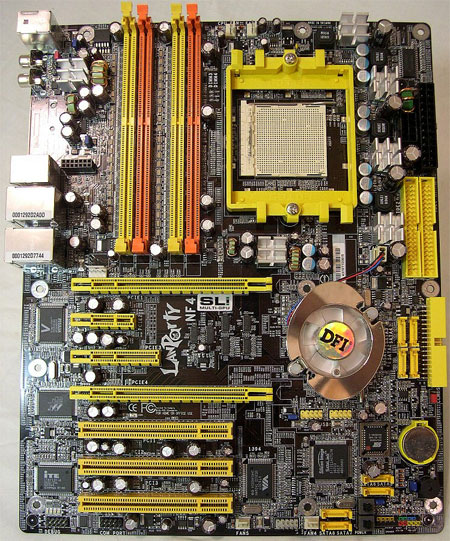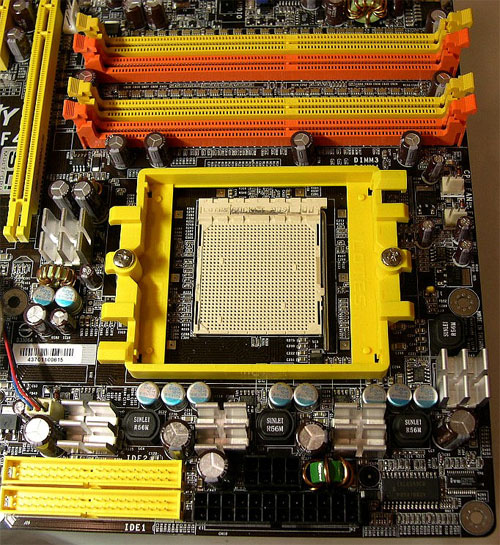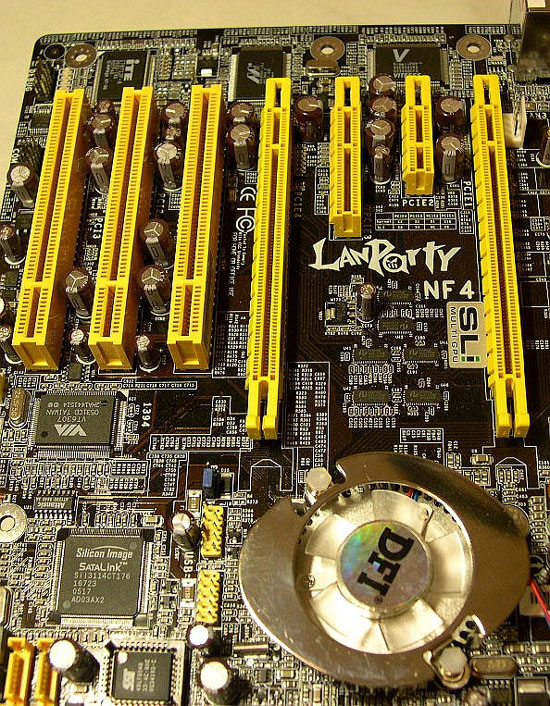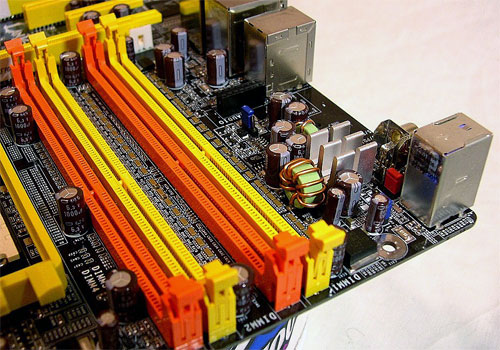DFI NF4 SLI-DR Expert – Can the best get better?
by Randi Sica on November 25, 2005 12:05 PM EST- Posted in
- Motherboards
DFI NF4 SLI-DR Expert: Feature Set
The SLI-DR Expert PCB is manufactured in DFI’s familiar black with UV reactive yellow color for the bulk of plastic components such as the PCI-e/PCI slots, IDE and Floppy connectors, and yellow and orange UV colors for the DIMM slots. The layout of components on this board is very good, with the IDE and Floppy connectors on the right side of the PCB, which generally works best in most cases. The trend recently has been to place floppy and/or an IDE at the bottom of the PCB, and it’s refreshing that DFI has shied away from this practice.
The original 4-pin Molex and the 4-pin P4 style connector have been replaced by an 8-pin 12V power connector placed next to the 24-pin ATX connector. During setup of the board, we came to realize that the PC Power and Cooling Turbo-Cool 510 SLI PSU on our review bench does not include this new style 12V plug, so we utilized the standard 4-pin 12V plug, which fit fine on one side of the 8-pin connector. We saw no ill effects on stability from using the 4-pin instead of an 8-pin connector. The 4-pin floppy-type connector for video remains above the 1st x16 PCI-E slot as was provided on the original SLI-DR.
The SATA 5, 6, 7 and 8 ports are controlled by the Silicon Image SIL 3114, which (to be honest) is a disappointment. With the SIL 3132 available, it would have made sense to include that SATAII controller, which would have given this board 8 SATAII channels and thus keeping this board future-proof and flexible. This omission is a hard one to figure out based on the many changes made on of this board, considering the current proliferation and wide availability of SATAII hard drives.
IEEE 1394 Firewire is controlled by the familiar VIA VT6307. Audio is provided by their Karajan 8 Channel audio card utilizing the AC97 codec, again the same setup as the previous generation. The board also boasts momentary switches for Power on and Reset like its previous version, along with the Vitesse and Marvel Gigabit Ethernet controllers.
The most obvious change is the 90 degrees counter-clockwise rotation of the CPU and memory. This layout was first seen on the DFI ATI based RDX200 CF-DR just recently introduced, and carried over to the Expert.
Compared to the original SLI-DR, the Expert includes some major changes in its design. In a conversation with OCZ Technology’s guru, Tony Leach, an expert in memory interfaces and BIOS, Tony pointed out: “The changes I know about fall mainly with memory drive strength. Engineer Oskar Wu has added even more resistors this time to allow near full drive from the memory controller. He also has routed the traces for the DIMMs over 4 layers to cut crosstalk to the bare minimum. DFI also use similar power regulation to the ATI reference boards, which I helped spec.”
The CPU power section includes the superb Nichicon capacitors to complement DFI’s overall use of high quality Japanese capacitors throughout the board. The major change here was the move to a 4-phase PWM power section as has been used on Intel based P4 boards for a number of years. 4 Phase power, through its ability to provide clean stable power, is noted for providing increased CPU, and hence, system stability. As has been the norm in DFI’s current lineup, inclusion of heat sinks on all MOSFETs is a nice touch and very effective.
Another major change in the Expert board is its x16 PCI-E slots. They have been moved farther apart, which facilitates the use of improved cooling. Graphics card coolers such as those manufactured by Arctic Cooling and others, certain types of water blocks, and phase change evaporators were very difficult or impossible to use on the original DFI as there just wasn’t enough room to use them. The additional spacing opens up the ability for end-users to use alternative cooling methods.
The other change involves the elimination of the SLI jumper system from the original SLI-DR. The original jumper system was a bit of headache to perform and is now switched from within the BIOS.
The only criticism that currently remains involves the northbridge fan, which cannot be avoided based on the board’s layout. Long graphics cards such as the NVIDIA 6800Ultra and 7800GTX can contact the fan housing.
The fan itself is a magnetic levitation design and is quiet and effective, a nice carry-over from the original SLI-DR.
This view illustrates the power section of the memory subsystem. Of note here is the addition of an Inductor and several additional capacitors, again, to provide the utmost in stability. The most apparent change is the elimination of the previous generation’s vDIMM jumper that allowed an end-user to switch the power supply provided from the 3.3V line to the 5V line. This, of course, allowed you to have at your fingertips 4V+ to apply to your RAM modules, especially modules such as BH-5, which required it to run 260 MHz+ with tight timings. The option to use 4V+ remains with this revision, but it is now simply a matter of just adjusting the memory voltage in the BIOS.
| DFI LP UT NF4 SLI-DR Expert | |
| CPU | . AMD® Athlon 64 X2 / Athlon 64 FX / Athlon 64 / Sempron . Socket 939 |
| Chipset | . NVIDIA nForce4 SLI - Supports NVIDIA SLI (Scalable Link Interface) |
| Front Bus Speeds | . 2000MT/s HyperTransport interface |
| Memory | . Four 184-pin DDR SDRAM DIMM sockets . Supports dual channel (128-bit wide) memory interface . Supports up to 4GB system memory . Supports PC2100 (DDR266), PC2700 (DDR333) and PC3200 (DDR400) DDR SDRAM DIMM |
| SLI / Single VGA Mode | . SLI mode - Use 2 SLI-ready PCI Express x16 graphics cards (identical cards) on the PCI Express x16 slots. - Each x16 slot operates at x8 bandwidth. When the graphics cards are connected via the SLI bridge, the total bandwidth of the two graphics cards is x16. . Single VGA mode - 1 PCI Express graphics card on the PCIE1 slot operates at x16 bandwidth. - The other PCI Express x16 slot (PCIE4) operates at x2 bandwidth. |
| BIOS | . Award BIOS . CMOS Reloaded . CPU/DRAM overclocking . CPU/DRAM/Chipset over-voltage . 4Mbit flash memory |
| Power Management | . Supports ACPI STR (Suspend to RAM) function . Wake-On-Events include: - Wake-On-PS/2 Keyboard/Mouse - Wake-On-USB Keyboard/Mouse - Wake-On-LAN - RTC timer to power-on the system . AC power failure recovery |
| Hardware Monitor | . Monitors CPU/system/chipset temperature . Monitors12V/5V/3.3V/Vcore/Vbat/5Vsb/Vchipset/Vdram voltages . Monitors the speed of the CPU fan, Fan 2 and Fan 3 - fan CPU Overheat Protection function monitors CPU temperature during system boot-up |
| FSB Frequency | 200Mhz-550Mhz in 1 Mhz increments |
| LDT Multiplier | Auto, 1X to 5X |
| USB 2.0 | . 6 USB 2.0/1.1 ports |
| Expansion Slots | . 2 PCI Express x16 slots . 1 PCI Express x1 slot . 1 PCI Express x4 slot . 3 PCI slots |
| Onboard SATA II/RAID | . Four Serial ATA ports supported by the nForce4 SLI chip - SATA speed up to 3Gb/s - RAID 0, RAID 1, RAID 0+1 and JBOD - NVIDIA RAID allows RAID arrays spanning across Serial ATA and Parallel ATA . Four Serial ATA ports supported by the Silicon Image Sil 3114 chip - SATA speed up to 1.5Gb/s - RAID 0, RAID 1, RAID 0+1 and RAID 5 |
| Onboard IDE | . Supports two IDE connectors that allows connecting up to four Ultra DMA 133Mbps hard drives . NVIDIA RAID allows RAID arrays spanning across Serial ATA and Parallel ATA . RAID 0, RAID 1, RAID 0+1 and JBOD |
| IEEE 1394 | . VIA VT6307 . Supports two 100/200/400 Mb/sec ports |
| Onboard LAN | . Dual Gigabit LAN - Vitesse VSC8201 Gigabit PHY and Marvell 88E8001 Gigabit PCI . Fully compliant to IEEE 802.3 (10BASE-T), 802.3u (100BASE-TX) and 802.3ab (1000BASE-T) standards |
| Onboard Audio | . Karajan audio module - Realtek ALC850 8-channel AC'97 audio CODEC - 6 audio jacks - 1 CD-in connector - 1 front audio connector . True stereo line level outputs . S/PDIF-in/out interface |
| BIOS Revision | Award (11/2/2005) Shipping Bios |
The SLI-DR Expert PCB is manufactured in DFI’s familiar black with UV reactive yellow color for the bulk of plastic components such as the PCI-e/PCI slots, IDE and Floppy connectors, and yellow and orange UV colors for the DIMM slots. The layout of components on this board is very good, with the IDE and Floppy connectors on the right side of the PCB, which generally works best in most cases. The trend recently has been to place floppy and/or an IDE at the bottom of the PCB, and it’s refreshing that DFI has shied away from this practice.
The original 4-pin Molex and the 4-pin P4 style connector have been replaced by an 8-pin 12V power connector placed next to the 24-pin ATX connector. During setup of the board, we came to realize that the PC Power and Cooling Turbo-Cool 510 SLI PSU on our review bench does not include this new style 12V plug, so we utilized the standard 4-pin 12V plug, which fit fine on one side of the 8-pin connector. We saw no ill effects on stability from using the 4-pin instead of an 8-pin connector. The 4-pin floppy-type connector for video remains above the 1st x16 PCI-E slot as was provided on the original SLI-DR.
The SATA 5, 6, 7 and 8 ports are controlled by the Silicon Image SIL 3114, which (to be honest) is a disappointment. With the SIL 3132 available, it would have made sense to include that SATAII controller, which would have given this board 8 SATAII channels and thus keeping this board future-proof and flexible. This omission is a hard one to figure out based on the many changes made on of this board, considering the current proliferation and wide availability of SATAII hard drives.
IEEE 1394 Firewire is controlled by the familiar VIA VT6307. Audio is provided by their Karajan 8 Channel audio card utilizing the AC97 codec, again the same setup as the previous generation. The board also boasts momentary switches for Power on and Reset like its previous version, along with the Vitesse and Marvel Gigabit Ethernet controllers.
The most obvious change is the 90 degrees counter-clockwise rotation of the CPU and memory. This layout was first seen on the DFI ATI based RDX200 CF-DR just recently introduced, and carried over to the Expert.
Compared to the original SLI-DR, the Expert includes some major changes in its design. In a conversation with OCZ Technology’s guru, Tony Leach, an expert in memory interfaces and BIOS, Tony pointed out: “The changes I know about fall mainly with memory drive strength. Engineer Oskar Wu has added even more resistors this time to allow near full drive from the memory controller. He also has routed the traces for the DIMMs over 4 layers to cut crosstalk to the bare minimum. DFI also use similar power regulation to the ATI reference boards, which I helped spec.”
The CPU power section includes the superb Nichicon capacitors to complement DFI’s overall use of high quality Japanese capacitors throughout the board. The major change here was the move to a 4-phase PWM power section as has been used on Intel based P4 boards for a number of years. 4 Phase power, through its ability to provide clean stable power, is noted for providing increased CPU, and hence, system stability. As has been the norm in DFI’s current lineup, inclusion of heat sinks on all MOSFETs is a nice touch and very effective.
Another major change in the Expert board is its x16 PCI-E slots. They have been moved farther apart, which facilitates the use of improved cooling. Graphics card coolers such as those manufactured by Arctic Cooling and others, certain types of water blocks, and phase change evaporators were very difficult or impossible to use on the original DFI as there just wasn’t enough room to use them. The additional spacing opens up the ability for end-users to use alternative cooling methods.
The other change involves the elimination of the SLI jumper system from the original SLI-DR. The original jumper system was a bit of headache to perform and is now switched from within the BIOS.
The only criticism that currently remains involves the northbridge fan, which cannot be avoided based on the board’s layout. Long graphics cards such as the NVIDIA 6800Ultra and 7800GTX can contact the fan housing.
The fan itself is a magnetic levitation design and is quiet and effective, a nice carry-over from the original SLI-DR.
This view illustrates the power section of the memory subsystem. Of note here is the addition of an Inductor and several additional capacitors, again, to provide the utmost in stability. The most apparent change is the elimination of the previous generation’s vDIMM jumper that allowed an end-user to switch the power supply provided from the 3.3V line to the 5V line. This, of course, allowed you to have at your fingertips 4V+ to apply to your RAM modules, especially modules such as BH-5, which required it to run 260 MHz+ with tight timings. The option to use 4V+ remains with this revision, but it is now simply a matter of just adjusting the memory voltage in the BIOS.















40 Comments
View All Comments
karioskasra - Saturday, November 26, 2005 - link
Agreed. The nb fan on the dfi sounds like a cat getting mauled. It's enough to make you go water just for the quiet.karioskasra - Saturday, November 26, 2005 - link
I'm calling for dual cores to be included in the standard test setup.Bozo Galora - Saturday, November 26, 2005 - link
newegg has them in stock - 2 billsdecptt - Friday, November 25, 2005 - link
I wanna ask the author.Have you tested 4x1GB yet?
Can it see 4GB or can't it?
What timing do you use?
RSica - Saturday, November 26, 2005 - link
I did not test with 4x 1GB sticks because I only have 2 in my possession for reviewing. I did in fact as mentioned run 4x512MB sticks at 2T with no problem whatsover for testing.Future reviews will very well see x2 A64's included but I'm not sure what the timetable will be for their inclusion.
Again, thank you for your comments !
Randi
cryptonomicon - Saturday, November 26, 2005 - link
i think the article said that it couldn't pass 1T for 4x1gb, but it can run it (at 2t).SignalPST - Friday, November 25, 2005 - link
Thanks Randi for the very detailed review of the Expert.I was wondering, with the new layout of the RAM slots and CPU, is it possible to populate all 4 RAM slots and still be able to fit the thermalright XP-120 without problems?
tjr508 - Friday, November 25, 2005 - link
Bravo to DFI for using decent power supplies and such, but why is the SIL 3114 such a dissapointment? Does any desktop user need SATA2 at this time? Does anyone need DDR2 as opposed to high quality DDR (not this board but in a couple months). This whole idea of "futureproofing" drives me crazy. It may be nice if people saw mobos they liked and baught them to keep them in a closet for a couple years, but I believe most people buy their systems within a week or so. I can understand buying a 3000+ and maybe sticking in a $30 fx57 in three or four years, but you can do that with any board on the market pretty much. Adopting future standards before they can provide reasonable performance improvements will alter your financial experience far more than your computing experience. Then again I would have to blame the consumers more so than the companies as their tactics are obviously making them money. I would love to know how many SLI boards out there have one video card attached to them as well as how many unsued SATA channels there are out there. I just think it is dissapointing that in today's market its hard to find an extra feature you want without paying for five more that you don't.Tanclearas - Friday, November 25, 2005 - link
I had to double-check that I was indeed still reading a review at Anandtech.Since when is the max FSB of a motherboard determined using any memory ratio other than 1:1?
How many other boards reviewed at AT were booted into Windows at a certain FSB before being cranked up?
Why the change in CPU from previous tests (using a 3500 rather than 4000)?
What is with the graph for Futuremark that compares the different component scores of the same board? What is the point of graphing those numbers?
Where is the comparison to the A8N32-SLI? I'm pretty sure that's the benchmark board right now for enthusiasts.
I didn't even finish reading the review.
RSica - Friday, November 25, 2005 - link
Good Morning :)_The object of the testing was to not only find the max 1:1 clockability of the board (310Mhz), but to find it's ability to reach the HTT limits of 2 different CPU's in our possession which certainly necessitates using a divider.
-This board booted into Windows at 510Mhz HTT. Having come from an extensive overclocking background, it is recognized that the fact a board will not boot into Windows at a specified speed does not necessarily mean the board/CPU will not function at an increased HTT speed. In this case, to determine the maximum HTT the Expert and 3500+ Winchester could attain the use of the Popular overclocking program ClockGen, and it only resulted in an additional 2Mhz HTT.
There are many readers that indeed take great interest in the overall top HTT overclockability of a board.
- The change in CPU's was merely to find the boards ability to overclock the HTT to it's maximum. This gem of a 3500+ was known to have reached an HTT of 500Mhz previously. The 4000+ has a maximum HTT of 400Mhz. Of course for all tests other than the Extreme Overclocking section, the 4000+ was utilized fror straight up comparisons.
-I have updated the gaming performance graphs which includes comparison to the A8N32-SLI
I'll update the other graphs as time allows.
I thank you wholeheartedly for your comments, Randi :)